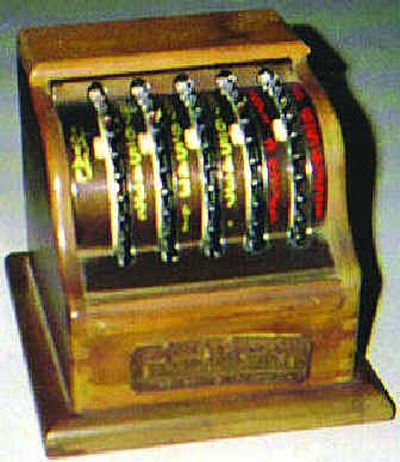Old adding machine from the ‘20s not worth much more than memories

Dear Collector: The enclosed photo is of an adding machine my grandparents had in their grocery store when I was a small child. I am curious to know if it has any value?
Capable of addition and subtraction, the Little Giant patented in 1924 by John Pfeifer of Springfield, Ohio, was unable to perform division or multiplication. Just one of many different machines used by merchants throughout the early part of the 20th century, this small cash register-shaped device has a wooden body with metal keys and inner workings. Now worth $20-$40, its greatest value is as a keepsake, adding up the memories of days past.
Dear Collector: I have a “Ranger Joe” bowl; could you tell me its value?
Patterned on a Western-themed advertising character, employed to sell cereal during the late 1930s in the Pennsylvania area, Ranger Joe was replaced as the spokesman in the 1950s when Nabisco purchased the company. Your 1951 glass bowl has a listed value of $15-$30.
Dear Collector: This Crosley radio was left to me by a relative who worked as a salesman for that company in the 1940s. Other than needing a new electrical cord, it works fine.
Probably predating your realtive’s employment, your 1933 table top model is not so much a radio as an architectural statement. With a Sheraton pediment and other fancy features, this five tube receiver resembles an ornate church, hence its style name: cathedral. Value in working order is between $300 and $400.
Dear Collector: Is this submarine lunch box worth anything?
Your 1960 metal box, without thermos, is listed for $50 in “Garage Sale & Flea Market Annual” (Collector Books, 2005, $19.95).
Dear Collector: I’ve copied the markings on this cup and saucer set, and include with them several pictures in the hope you can identify their age and maker.
The intertwined initials on the shield stand for Heber & Company, a Bavarian porcelain factory located in the city of Neustadt. The timeline on your set is somewhere in the first quarter of the 20th century, which is when this maker was in operation.
Dear Collector: Recently I found a trove of comic books, mostly from the 1960s. Included among them is a March 1967 copy of “Rat Patrol.” I was a big fan of the television series, but don’t recall any comic books based on the show. Is it a rare book?
Since there were only six issues (of which yours was the first), I can understand why you never knew about the comics. Your Dell publication, with Christopher George on the cover, is worth $20.
Dear Collector: During WWII my father traded some of his American cigarettes for this New Zealand coin, presumably with a soldier from that country. While I would never think of selling it, I have often wondered if it is valuable?
This small silver coin, called a florin, bears the portrait of King George the Fifth on one side and a kiwi (the flightless bird after whom the New Zealanders label themselves) on the other. Worth about $2 on today’s market, your souvenir has a priceless story behind it.